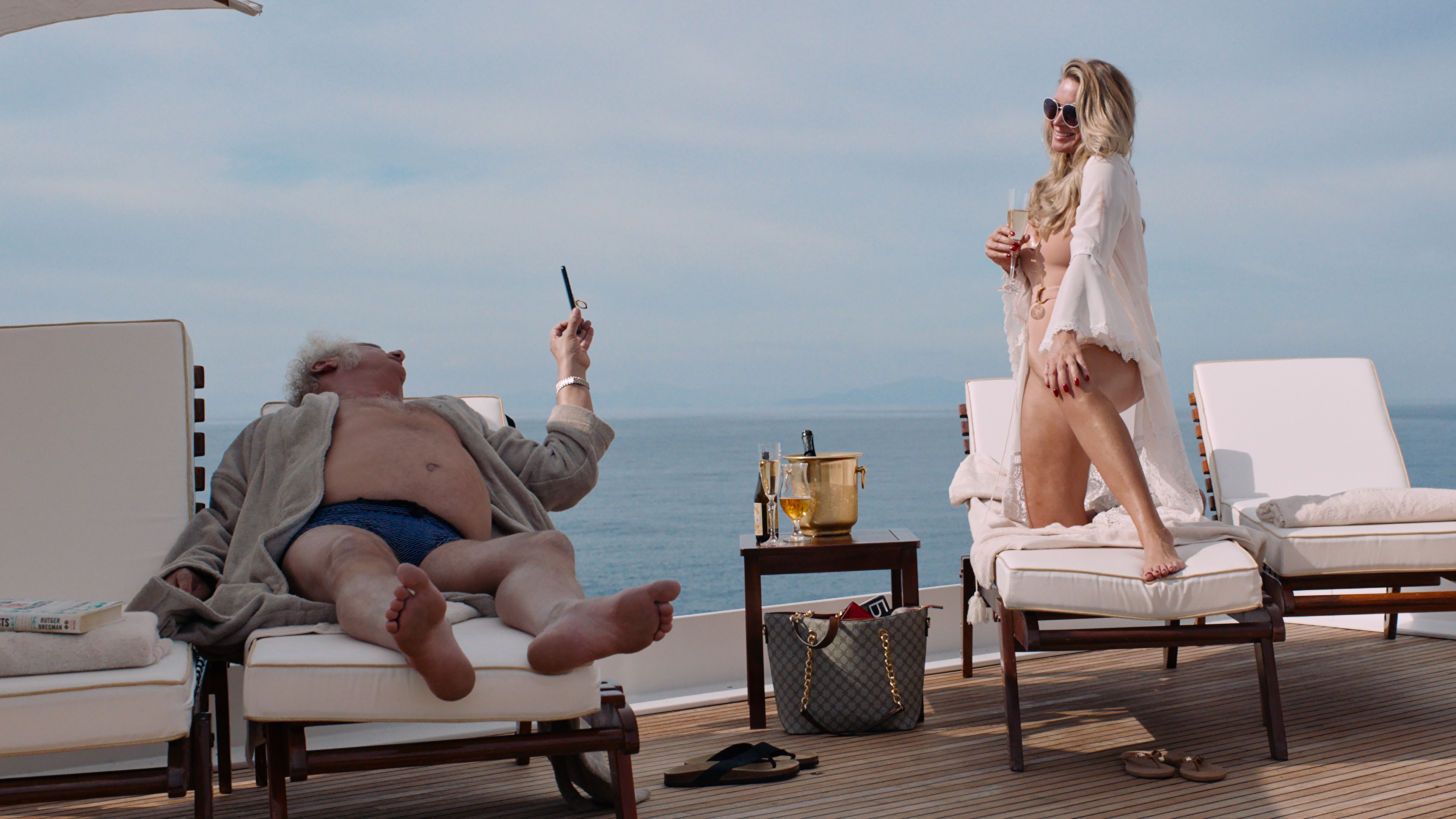You’d think Ruben Ostlund wrote for Seinfeld the way he likes to construct entire narratives out of misunderstandings and awkward moments. You may recall Ostlund was the one who brought us 2014’s Force Majeure, the film exploring the aftermath of a father’s cowardly decision to flee a ski resort avalanche, leaving his wife and children in the path of it. (The avalanche didn’t actually hurt anyone, making the film a black comedy rather than a tragedy.) There was less of a central awkwardness fuelling his 2017 follow-up, The Square, though the film examines disintegrations of the social order against the backdrop of the art world, and feels like a communication breakdown throughout.
Triangle of Sadness also begins with a trademark uncomfortable exchange. Carl (Harris Dickinson) and Yaya (Charlbi Dean) are fashion models in a romantic relationship, and she’s also a social media influencer, the latter explaining why she makes more money than he does. This becomes relevant when she leaves the bill sitting on the table after an expensive dinner, pretending she didn’t see it, even though she said last time she’d pick up the next cheque. When he finally moves to pick it up, and is met with no resistance, it kicks off a lengthy debate about gender roles and each person’s expectations of the relationship.
Ostlund is never a predictable one in terms of structure, and before you know it Carl and Yaya have receded into an ensemble cast aboard a luxury yacht. This is a typical in-kind payment for Yaya’s social media influencing, but everyone else is there because they’re filthy rich. What has all the trappings of a wealthy pleasure cruise threatens to become something different when we meet the captain (Woody Harrelson), who’s unshaven, unkempt, in his cabin since the start of the trip, and with a worrisome twitch in his eye. Whether he’ll get himself in shape in time for the captain’s dinner, a focal point of the trip, is anybody’s guess. But the passengers may wish to watch what they eat at that particular dinner.
Triangle of Sadness doesn’t just seem like it has three distinct parts. It actually breaks the film in thirds by chapter headings, and we shouldn’t give away the identity of the third and final chapter. Not talking about what happens in the final portion of the movie does make it a bit difficult to talk about its themes, but let’s just say that any similarities to either The Menu or Glass Onion: A Knives Out Mystery are not coincidental. There’s clearly something in the air to hold rich people accountable for decades and centuries of having things their way, even more so than there is in a typical year in the film industry.
The distinct thing Ostlund brings to this sort of material is a European light absurdity that’s just delicious for audiences to consume. Whereas other directors – maybe not specifically Mark Mylod and Rian Johnson, but directors with Hollywood sensibilities – work overtime to show just how cruel and entitled their rich people are, and therefore how deserving they are of comeuppance, Ostlund is more content to let small details speak for themselves. The rich people aboard this boat aren’t particularly vulgar or rude to the staff – in fact Carl, a relative pauper, may act more entitled than the actual millionaires.
However, this also dovetails with the sense of randomness that informs Ostlund’s work. Ostlund isn’t interested in what should happen according to traditional movie values. Life is rarely like that. Besides, the concept of wealth isn’t absolute, but rather, defined by what the market needs or will bear. (And if you want a true treatise on randomness, consider that star Charlbi Dean died of sepsis at age 32 just before this film’s premiere. That’s a reminder of the unfairness of life if ever there was one.)
Ostlund is, instead, quite interested in the aftermath of what happens on that boat. (It’s no spoiler to say that something happens, because of course it does – otherwise there would be no movie.) Characters from all stations, including the boat’s crew, find themselves questioning the underlying assumptions of their collective dynamic. And this is where Triangle of Sadness reaches its richest and most rewarding material – even if we can’t talk about it in a review.
Although it isn’t really warranted to compare Ostlund and Rian Johnson, despite a similarity in the subject matter of their 2022 films, there does emerge a useful point of contrast between them. Johnson’s Glass Onion is a veritable narrative puzzlebox, one that ends exactly as was ordained from the very beginning. A perfectionist like Johnson can’t imagine a different outcome. Ostlund is comparatively messy, preferring chaos to order. In Triangle of Sadness, this is reflected most clearly in the final shot, a puzzling sort of disjuncture without a clear answer. As the last taste left in the viewer’s mouth, it threatens to reduce a viewer’s overall assessment of the film.
What will always be refreshing about Ostlund’s approach, though, is that you really don’t know where he is going to end up – only that it will seem true, even if it isn’t wrapped up neatly with a bow. The titular triangle doesn’t have anything to do with Bermuda, but rather, a crease above the model’s nose that can be emphasised or deemphasised depending on the kind of photo shoot it is. But just as the Bermuda Triangle is a place of unknown wonders and opportunities for disaster, so is a film by Ruben Ostlund, none more so than this.
Triangle of Sadness is currently playing in cinemas.



